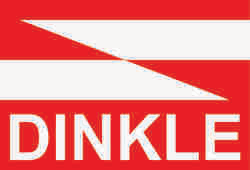
DINKLE Corporation USA
DINKLE Corporation USA is a leading international manufacturer specializing in terminal blocks. With a global presence, DINKLE provides reliable and high-quality products to various industrial sectors worldwide.
DINKLE's terminal blocks are widely utilized in diverse industries such as Factory Automation, Process Automation, Power Automation, Railway Transportation, New Energy, and Equipment Manufacturing. These essential components play a crucial role in ensuring secure and efficient electrical connections within these sectors.
One notable advantage of DINKLE terminal blocks is their ubiquity in industrial settings. Their products can be easily found and integrated into numerous applications across different industries. This widespread usage highlights the trust and confidence that professionals place in DINKLE's solutions.
To ensure the utmost quality, all DINKLE factories have obtained ISO 9001 and ISO 14001 certifications. These globally recognized standards validate DINKLE's commitment to consistent product excellence and environmental responsibility.
Moreover, DINKLE's terminal blocks boast several safety approvals, including UL, CUL, CSA, VDE, and GB certifications. These approvals signify that DINKLE's products meet rigorous safety standards and regulations, ensuring the utmost protection for users and equipment.
In addition to safety certifications, DINKLE also prioritizes environmental sustainability. The materials used in manufacturing their terminal blocks comply with RoHS and REACH environmental standards set by the European Union. This dedication to eco-friendly practices highlights DINKLE's commitment to reducing its environmental footprint.
In conclusion, DINKLE Corporation USA is a prominent global manufacturer of terminal blocks with a strong presence in various industrial sectors. Their products are renowned for their reliability, safety certifications, and compliance with environmental standards. Professionals across the world trust DINKLE's terminal blocks to provide secure and efficient electrical connections in their applications.
Shock Sensors
Results:
Results remaining:0
Applied Filters:
DINKLE Corporation USA
No data |
About Shock Sensors
Shock sensors are specifically engineered to detect and promptly respond to sudden changes in acceleration. These sensors primarily operate using piezoelectric principles, which generate electrical charges in response to mechanical stress. Several key characteristics define the performance and functionality of shock sensors, including sensor type, sensing range, sensitivity, and mounting type. Sensor Types: There are two primary sensor types utilized in shock sensors: ball and vibration (Piezo film). Ball sensors utilize a small metal ball that moves within a conductive housing, generating electrical signals when subjected to accelerative forces. Vibration sensors employ Piezo film, which generates electrical charges when deformed by vibrations or shocks. Sensing Range: The sensing range of shock sensors refers to the extent of acceleration they are capable of detecting. This range typically spans from 0 to 1500 G, with G representing the acceleration due to gravity. Sensitivity: Sensitivity measures the magnitude of electrical charge or voltage produced by the shock sensor in response to a given acceleration. Sensitivity is expressed in units of charge per unit of acceleration (pC/G) or millivolts per unit of acceleration (mV/G). The available sensitivities for shock sensors vary and include options such as 0.055 pC/G, 0.09 pC/G, 0.350 pC/G, 0.608 pC/G, 0.840 pC/G, or 1 mV/G. Mounting Type: The mounting type refers to the manner in which the shock sensor is installed or attached to the system or equipment being monitored. Common mounting options include screw mount, adhesive mount, or surface mount, allowing for flexibility in installation based on the specific application requirements. In summary, shock sensors are specialized devices designed to detect and respond to sudden changes in acceleration. They utilize piezoelectric principles and offer various characteristics such as sensor type (ball or vibration), sensing range (0 to 1500 G), sensitivity (expressed in pC/G or mV/G), and mounting type (screw mount, adhesive mount, or surface mount). These features enable shock sensors to accurately measure and monitor accelerations in different industrial applications.
